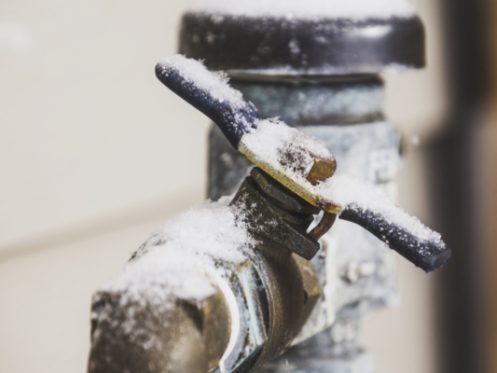Your Pipes Are Frozen, Now What?
With the cold weather in full swing in the Denver area, frozen pipes pose a real threat to any home. Frozen pipes do more than prevent water from getting to appliances and exiting sites like faucets and showers; frozen pipes can also burst. The pipe can only handle so much pressure as water builds up behind the frozen section. When this happens, the pipe will burst, and you’ll need to make a costly repair.
If you suspect you have a frozen pipe it’s important that you act quickly, especially if the frozen section of pipe is on the upper levels of your home. A burst pipe behind a wall can pour water down between your walls, eventually leading to rot and other structural damage without you even knowing. It’s important to know how to identify a pipe that might be at risk of freezing, or a pipe that’s already frozen, as well as how to quickly fix the problem before the pipe bursts so that you can help prevent repairs.
Preventing Frozen Pipes
The best way to deal with a frozen pipe is to make sure your pipes don’t freeze in the first place. The pipes most at risk are the ones running closest to the outdoors in unheated spaces. Pipes running through the basement, crawl spaces, the attic or eaves of your home, or your garage are other pipes to look out for. Since these areas are usually not heated or, worse, sometimes not even properly insulated, the pipes can quickly freeze if there is a major drop in temperature.
One way to help prevent these pipes from freezing is to wrap them with pipe insulation. Pipe insulation is relatively cheap, only costing about 50 cents per foot. If temperatures dip below 20 degrees, there is a serious risk of pipes freezing, especially if they are uninsulated. You can also take steps inside the home to prevent pipes from freezing. This includes keeping the thermostat set to the same temperature during the day and night (generally above 55 degrees), running cold water on occasion to keep the water from stagnating in the pipes, letting the cold-water drip when the faucet isn’t in use, keeping your garage doors closed, and adding insulation to parts of the house that are not insulated.
In extreme circumstances, there are pipe heating systems you can also purchase that you can plug into a standard outlet to help keep the pipes that are most exposed to the elements or outside temperatures above freezing temperatures. Lastly, you should drain any pipes that are likely to freeze that you won’t be using during the winter. This includes things like pool supply pipes, hoses, and outdoor pipe systems like sprinkler systems.
How to Tell You Have a Frozen Pipe
One of the earliest warning signs that indicate that you have a frozen pipe is if you have a severe drop off in water pressure or outflow coming out of the supplied fixture; worse yet, you may have no water at all. Another clear indication you have a frozen pipe is if you see bulging or ice surrounding a section of exposed pipe. Closed systems like water heating systems tend to also have pressure meters you can check to ensure the water pressure in the system is at a normal level. Lastly, if a pipe is starting to freeze or is on the verge of freezing, sometimes the outside of the pipe will start to form condensation from the temperature difference.
Check areas under the pipe for wet spots or dripping, which indicates there is a problem. If you see any indication that you might have a frozen pipe, turn off the main water valve immediately to prevent any more pressure from building up in the affected pipe. Once that is taken care of, you can start dealing with the frozen section of the pipe.
How to Fix a Frozen Pipe
Once you’ve identified the problem section of the pipe, there are a few things you need to do to fix the problem. First, make sure the faucets or outflow where the pipe eventually empties is open. This will allow the water to exit the pipe once the frozen section is eventually cleared rather than causing even more pressure to build as the frozen section melts. Second, keep cabinets and doors around where the pipe is located open to allow the surrounding heat from your home to reach the pipe. Finally, heat the pipe. The most effective way to do this is to wrap the pipe with heating pads, and warm towels that have come out of the dryer. You could also use a hair dryer.
Make sure to keep an eye out for any leakage from the pipe and avoid using any electronic heating source if you suspect the pipe is leaking to avoid electrocution. Avoid using any kind of open flame to heat the affected pipe as this could pose a fire hazard. It might take a while for the pipe to thaw with whichever method you choose to use, so be patient.
Once you’re confident the frozen section of the pipe has thawed, inspect the pipe for any sign of leakage or cracks. Dry the pipe with a towel and inspect it again for any condensation or dripping. If the pipe looks to be intact, it’s time to conduct a test and turn the water back on. Leave the faucets open, and open the main water valve. Then, inspect the pipe again to make sure there is nothing leaking. If there is a leak, shut off the main valve immediately and mop up as much of the water as you can with towels, sponges, mops, and wet vacuums before calling a professional plumber to get the repair process started.
Fixing a Damaged Pipe
If a pipe has been damaged by freezing temperatures, how easy it is to fix depends a lot on where the pipe is located and what kind of pipe it is. Short pipes between junctions are generally easier to fix since the entire small section can just be replaced. But breaks in a pipe that runs a long span — long water heating pipes that run inside the walls, for example — can be a lot more difficult. If you have a pipe that was damaged, your best option is to call a professional plumber to assess the damage and handle the repair process for you.
If need help with the winterizing process to make sure your plumbing is all ready for the cold weather, or you suspect you have a frozen pipe or a pipe at risk for freezing, our professionals at High 5 Plumbing in Denver can help. Our business received the 2021 Angi Super Service Award and the Denver Metro Chamber of Commerce 2022 Small Business Award. Furthermore, we are committed to giving back and supporting the community through generous donations. Our plumbing services include water heater installation and repair, drain cleaning, sump pump installation and service, hydro-jetting, fixture installation, and sewer line repair and installation. Call High 5 Plumbing today to schedule an appointment.


